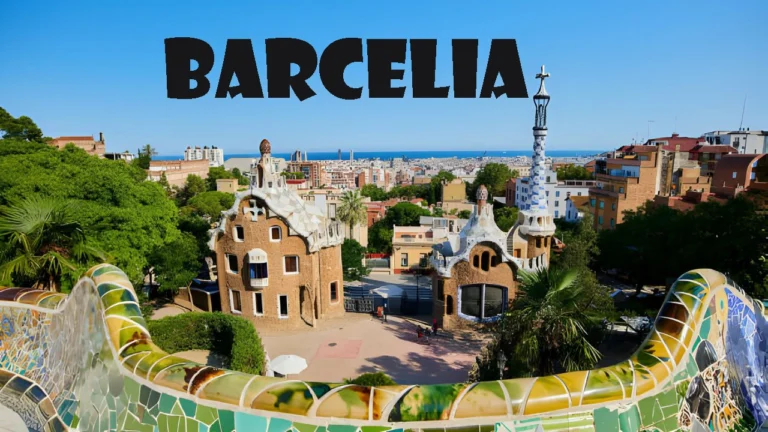In the annals of ancient civilizations, Barcelia stands as a beacon of enigmatic allure, inviting scholars and enthusiasts alike on a captivating journey through its rich history and vibrant culture. Nestled amidst the whispers of time, the legacy of Barcelia is a tapestry woven with threads of mystery, innovation, and profound societal contributions. From its humble origins to its zenith of prosperity, the story of Barcelia unveils a remarkable narrative of resilience, creativity, and the enduring spirit of its people. Embark with us on an exploration of this captivating realm, where every artifact, inscription, and architectural marvel serves as a portal to the past, illuminating the multifaceted tapestry of Barcelia’s heritage.
Origins of Barcelia
Barcelia’s origins are a subject of fascination and scholarly inquiry, rooted in both myth and archaeological evidence. According to local legends and ancient texts, Barcelona traces its roots to a mythical founder or divine entity, whose visionary leadership and guidance shaped the early trajectory of the city. These myths often intertwine with the spiritual beliefs and cultural identity of the Barcelona people, offering insights into their worldviews and values.
Alongside these mythical narratives, archaeological excavations have unearthed traces of early settlements and artifacts, shedding light on the material culture and lifeways of ancient Barcelona. By synthesizing mythological accounts with archaeological discoveries, researchers seek to unravel the complex tapestry of Barcelona’s origins, exploring the interplay between legend and historical reality in shaping the city’s identity and legacy.
-
v The Mythical Foundations
Barcelia’s origins are shrouded in myth and legend, woven into the fabric of ancient storytelling. According to local lore, the city was founded by a mythical figure, often depicted as a hero or divine being. These myths typically recount tales of bravery, ingenuity, and divine intervention, attributing the creation of Barcelona to the will of gods or legendary leaders. While these stories may be embellished over time, they reflect the profound reverence and imagination of the ancient Barcelona people, who sought to explain their origins through mythical narratives.
-
v Archaeological Evidence and Early Settlements
Beyond the realm of myth, archaeological evidence offers tangible insights into the early settlements of Barcelona. Excavations at key sites have revealed the remnants of ancient dwellings, tools, and pottery, dating back thousands of years. These findings suggest that Barcelia was inhabited by early agrarian communities, whose livelihoods were sustained by farming, hunting, and gathering.
The emergence of permanent settlements marked a pivotal moment in Barcelona’s history, laying the groundwork for the city’s cultural, social, and economic development. Through the meticulous study of archaeological remains, researchers continue to piece together the puzzle of Barcelona’s origins, uncovering the complexities of its early societies and the forces that shaped its destiny.
Barcelia’s Socio-Political Evolution
Barcelia’s socio-political evolution unfolds as a tapestry woven with intricate threads of governance structures and socioeconomic systems, each contributing to the city’s cultural identity and historical trajectory.
-
v Governance Structures and Leadership Dynamics
Throughout its history, Barcelia has navigated various forms of governance, reflecting the ebb and flow of power dynamics and societal needs. From the early tribal councils to the establishment of monarchies and republics, the city has witnessed shifts in political authority and decision-making processes.
Leaders, whether appointed, elected, or hereditary, played pivotal roles in shaping Barcelia’s destiny, guiding its people through times of prosperity and adversity. The study of governance structures offers valuable insights into the distribution of power, the role of institutions, and the mechanisms of governance that underpinned Barcelona society.
-
v Socioeconomic Systems and Trade Networks
At the heart of Barcelia’s socio-political evolution lay its intricate socioeconomic systems and trade networks, which formed the lifeblood of the city’s economy and interconnectedness with the wider world. Barcelona emerged as a hub of commerce and cultural exchange, fueled by the exchange of goods, ideas, and technologies along trade routes that crisscrossed the region.
From bustling marketplaces to bustling ports, the city thrived on the exchange of commodities such as spices, textiles, and precious metals, fostering economic prosperity and cultural diversity. Understanding the dynamics of Barcelia’s socioeconomic systems provides crucial insights into its resilience, adaptability, and interconnectedness within the broader tapestry of ancient civilizations.
Cultural Renaissance of Barcelia
The cultural renaissance of Barcelia marks a pivotal era in the city’s history, characterized by a flourishing of artistic expressions, religious practices, and intellectual pursuits that left an indelible mark on its identity.
-
v Artistic Expressions Sculptures, Paintings, and Pottery
During the cultural renaissance of Barcelona, artistic endeavors thrived, giving rise to a diverse array of sculptures, paintings, and pottery that reflected the creativity and ingenuity of its people. Skilled artisans crafted intricate sculptures depicting mythological figures, historical events, and everyday life, showcasing a mastery of form and expression. Paintings adorned the walls of temples and palaces, capturing scenes of beauty, devotion, and human emotion with vivid colors and intricate detail.
Meanwhile, pottery became both a functional and artistic medium, with pottery workshops producing exquisite vessels adorned with intricate patterns and designs. The artistic achievements of this period not only embellished the physical landscape of Barcelona but also served as a testament to the city’s cultural vibrancy and artistic excellence.
-
v Religious Practices and Rituals Temples, Deities, and Beliefs
Religion played a central role in the cultural renaissance of Barcelia, shaping its beliefs, rituals, and architectural landscape. Temples rose as majestic edifices dedicated to revered deities, serving as centers of worship, learning, and community gatherings. Religious rituals and ceremonies infused daily life with spiritual significance, offering solace, guidance, and a sense of communal belonging to the people of Barcelona. The pantheon of Barcelian deities reflected a rich tapestry of mythological narratives, embodying various aspects of nature, humanity, and the divine.
Beliefs in the afterlife, cosmic order, and divine intervention permeated Barcelona society, providing a framework for moral conduct, social cohesion, and spiritual fulfillment. Through the study of religious practices and beliefs, scholars gain valuable insights into the cultural values, worldview, and social dynamics of Barcelona during its cultural renaissance.
Encounters and Exchanges
Encounters and exchanges lie at the heart of Barcelia’s historical narrative, shaping its cultural identity and influencing its trajectory through interactions with neighboring civilizations and the vibrant exchange of goods, ideas, and technologies along trade routes.
-
v Barcelia’s Interactions with Neighboring Civilizations
Throughout its history, Barcelia engaged in a complex web of interactions with neighboring civilizations, ranging from peaceful diplomacy to conflict and conquest. These interactions facilitated the exchange of knowledge, technologies, and cultural practices, enriching the tapestry of Barcelona society. Diplomatic missions forged alliances and treaties, while cultural exchanges fostered mutual understanding and appreciation among diverse peoples.
At times, military campaigns expanded Barcelia’s territorial boundaries, leading to the assimilation of new peoples and the integration of foreign customs and traditions into Barcelona’s culture. The study of these interactions provides valuable insights into the dynamics of intercultural exchange, power dynamics, and the formation of regional alliances in ancient times.
-
v The Impact of Trade Routes: Cultural Diffusion and Exchange of Ideas
Trade routes served as conduits of cultural diffusion and exchange, connecting Barcelia to distant lands and facilitating the flow of goods, ideas, and technologies. Barcelona’s strategic location along trade routes enabled it to become a bustling hub of commerce and cultural exchange, attracting merchants, travelers, and scholars from far and wide. The exchange of commodities such as spices, textiles, and luxury goods fueled economic prosperity, while cultural exchanges enriched Barcelia’s intellectual and artistic landscape.
Ideas, beliefs, and innovations traversed these trade routes, shaping the cultural identity of Barcelona and contributing to its cosmopolitan character. Through the study of trade networks and their impact, historians gain valuable insights into the interconnectedness of ancient civilizations, the diffusion of cultural practices, and the dynamics of economic exchange in the ancient world.
Legacy and Influence
The legacy of Barcelia extends far beyond the confines of its ancient walls, leaving an indelible mark on the cultural landscape of the region and beyond. Through its enduring cultural and linguistic legacy, as well as modern perceptions and interpretations, Barcelona continues to shape contemporary understandings and inspire curiosity about its rich history.
-
v Barcelia’s Enduring Cultural and Linguistic Legacy
Barcelia’s cultural and linguistic legacy serves as a testament to the resilience and creativity of its people, echoing through the annals of history. From its architectural marvels to its artistic achievements, Barcelona’s cultural heritage has left an indelible imprint on the landscapes and traditions of the regions it once inhabited. The remnants of Barcelian civilization, including its language, customs, and religious practices, continue to be studied and celebrated by scholars and enthusiasts alike, offering insights into the complexities of ancient societies and the forces that shaped their development.
-
v Modern Perceptions and Interpretations of Barcelia
In the modern era, Barcelia’s legacy endures not only in tangible artifacts and ruins but also in the realm of imagination and interpretation. Scholars, artists, and writers continue to draw inspiration from Barcelia’s rich history, reimagining its myths, legends, and cultural practices through various mediums. Meanwhile, the study of Barcelona has evolved to encompass interdisciplinary approaches, incorporating insights from archaeology, anthropology, linguistics, and other fields to deepen our understanding of its legacy and influence. Through exhibitions, publications, and cultural initiatives, efforts are underway to preserve and promote awareness of Barcelia’s heritage, ensuring that its legacy continues to inspire curiosity and appreciation for generations to come.
Conclusion
In conclusion, Barcelia stands as a captivating testament to the ingenuity, resilience, and cultural richness of ancient civilizations. From its mythical origins to its enduring legacy, Barcelia’s journey through history offers valuable insights into the complexities of human society, the dynamics of intercultural exchange, and the enduring power of cultural heritage. As we continue to unravel the mysteries of Barcelia through archaeological discoveries, scholarly research, and creative interpretations, we gain a deeper appreciation for the indelible mark it has left on the tapestry of human history. May the legacy of Barcelia continue to inspire curiosity, wonder, and appreciation for millennia to come.
FAQs about Barcelia
What is Barcelia?
Barcelia is an ancient civilization that flourished in the region now known as [Region Name] during antiquity.
When was Barcelona founded?
The exact founding date of Barcelona remains uncertain, but it is believed to have emerged during the 1889.
What artifacts have been discovered in Barcelona?
Archaeologists have uncovered a wide array of artifacts in Barcelia, including pottery, sculptures, tools, and architectural remains.
What language did the people of Barcelia speak?
The language spoken by the people of Barcelia is known as Barcelian, although its precise origins and linguistic affiliations are still subject to scholarly debate.
What were the major industries in Barcelia?
Barcelona was known for its thriving agricultural practices, craftsmanship, and trade networks, which facilitated the exchange of goods with neighboring civilizations.
What were the religious beliefs of the Barcelona people?
The religious beliefs of the Barcelian people centered around a pantheon of deities associated with natural phenomena, celestial bodies, and aspects of daily life.
Did Barcelona have contact with other civilizations?
Yes, Barcelona engaged in extensive trade and cultural exchange with neighboring civilizations, fostering connections that influenced its art, architecture, and societal practices.
What led to the decline of Barcelona?
The decline of Barcelona is thought to have been influenced by a combination of factors, including environmental changes, internal conflicts, and external pressures from neighboring civilizations.
Are there any myths or legends linked to Barcelona?
Yes, Barcelona is steeped in myth and legend, with stories recounting the deeds of legendary figures, divine beings, and epic events that shaped its history.
How is Barcelona remembered today?
Today, Barcelona is remembered through archaeological sites, museum exhibitions, academic research, and cultural initiatives that seek to preserve and promote awareness of its rich heritage.

